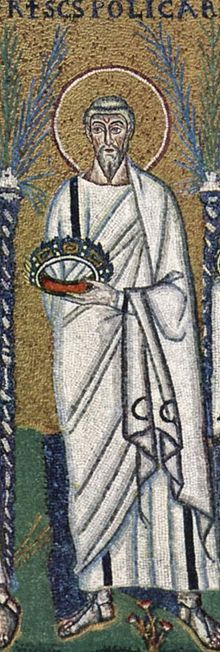Martyrdom of Polycarp

St Polycarp, Bishop of Smyrna
|
|
| Author | Apostolic Fathers |
|---|---|
| Language | Greek, Latin |
| Subject | Hagiography |
| Set in | 2nd century |
| Published |
|
| Text | at |
The Martyrdom of Polycarp is one of the works of the Apostolic Fathers, and as such is one of the very few writings from the actual age of the persecutions. Polycarp was Bishop of Smyrna around the years AD 155-160 (possibly AD 170-180). The letter as a whole takes influence from both Jewish martyrdom texts in the Old Testament and the Gospels. Furthermore, the Martyrdom of Polycarp promotes an ideology of martyrdom, by delineating the proper conduct of a martyr.
Modern critical editions of the Martyrdom of Polycarp (MartPol) are compiled from three different categories of manuscript: seven Greek manuscripts, the fourth century Ecclesiastical History of Eusebius of Caesarea, and a single Latin manuscript. The Greek manuscripts are all from the tenth to the thirteenth centuries. Of the seven manuscripts, six provide a similar account of the martyrdom of Polycarp and are thus believed to represent a single family of texts. The seventh manuscript, however, known as the Moscow Codex and dating to the thirteenth century, contains a more elaborate final chapter (22.2–3).
In addition to the Greek manuscripts there are also the writings of Eusebius related in his Ecclesiastical History, written around AD 324–325. Eusebius heavily summarizes the martyrdom and ends his account at 19.1, omitting the concluding sections that relate the transmission of the text, as well as the passion narrative parallels.
The Latin version of the Martyrdom dating from the tenth century exists as an independent account of the martyrdom but does not offer any variance upon the text. There is also an Old Church Slavonic translation that serves as an independent witness.
Little external evidence exists to aid in the dating of the Martyrdom of Polycarp, therefore historians have found it beneficial to assign a date to the actual death of Polycarp. Three dates have been proposed for the date of Polycarp's death:
The 'Martyrdom' of Polycarp, along with other documents of the Apostolic Fathers plays a central role in bridging the New Testament and emerging Christian writers in the latter half of the second century, such as Justin Martyr and Irenaeus. In his youth he is said to have known the apostles and in his later years also Irenaeus.
Due to the potentially linking historical weight that the martyrdom text carries its historicity is a point of debate in scholarship.
A challenge to the dates could well call into question the authenticity of the document itself. Part of the skepticism regarding the MartPol text has centered on the number of parallels with the passion narratives of the Gospels, including Polycarp’s prediction of his capture and death (5.2), the eirenarch named Herod (6.2), the arrest of Polycarp "with weapons as if he were a criminal" (7.1), and Polycarp being carried on a donkey back to Smyrna (8.1), miraculous occurrences such as the ‘voice from heaven’ urging Polycarp to ‘Be strong and be a man!’ (9.1). On the other hand, the fact of an overlay of interpretation does not necessarily in itself invalidate the historicity. Moreover, none of these elements is completely implausible; the name Herod, for example, is a common name for an aristocratic Jew and the association of Christians with donkeys is well documented.
...
Wikipedia
